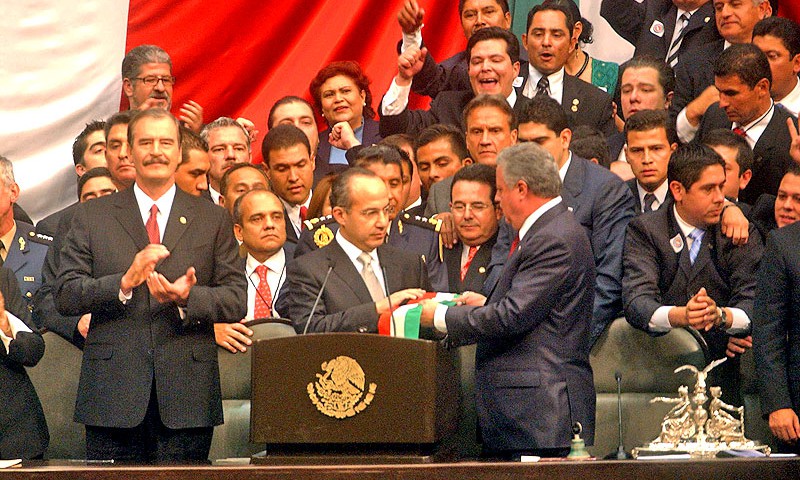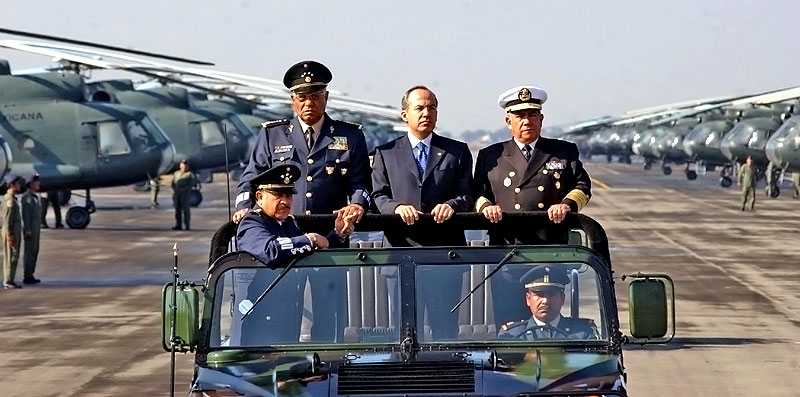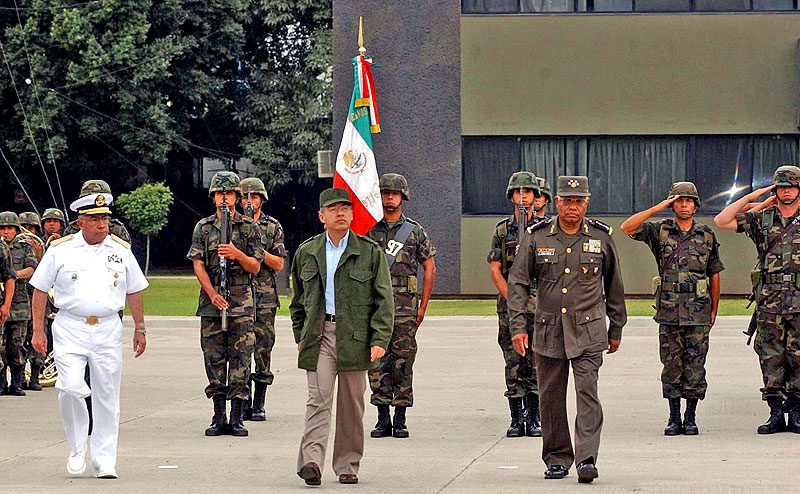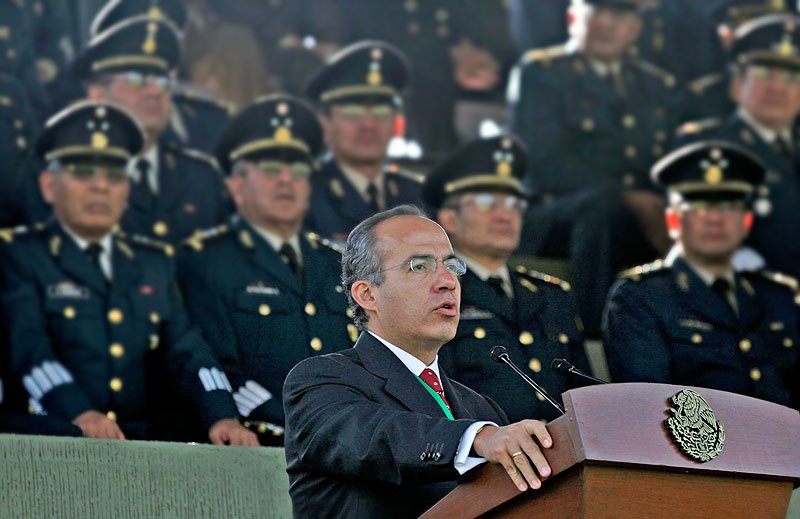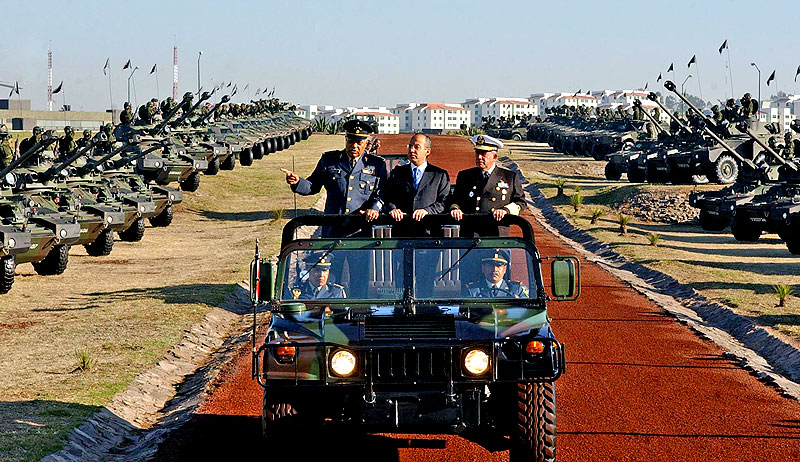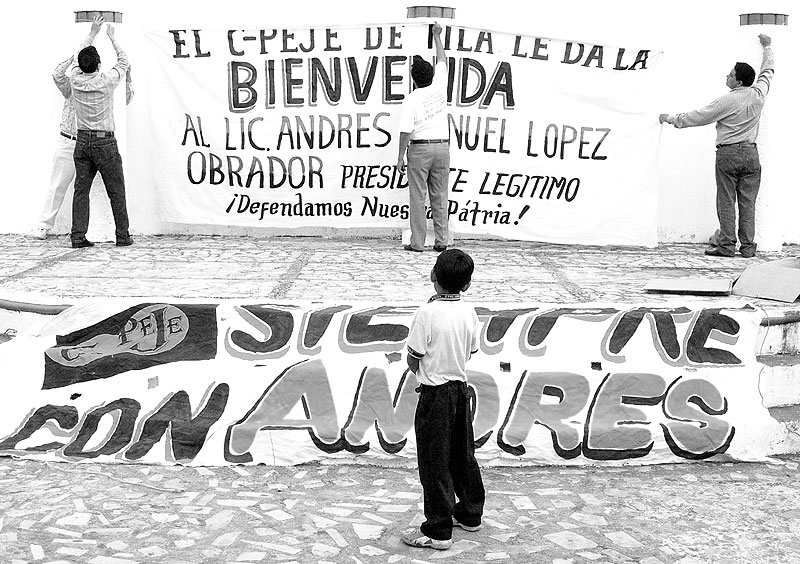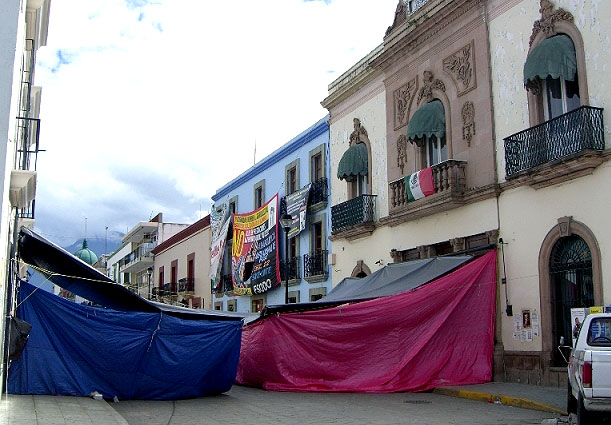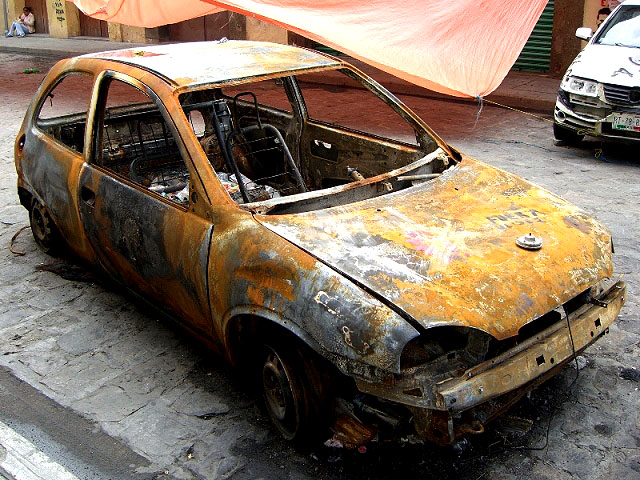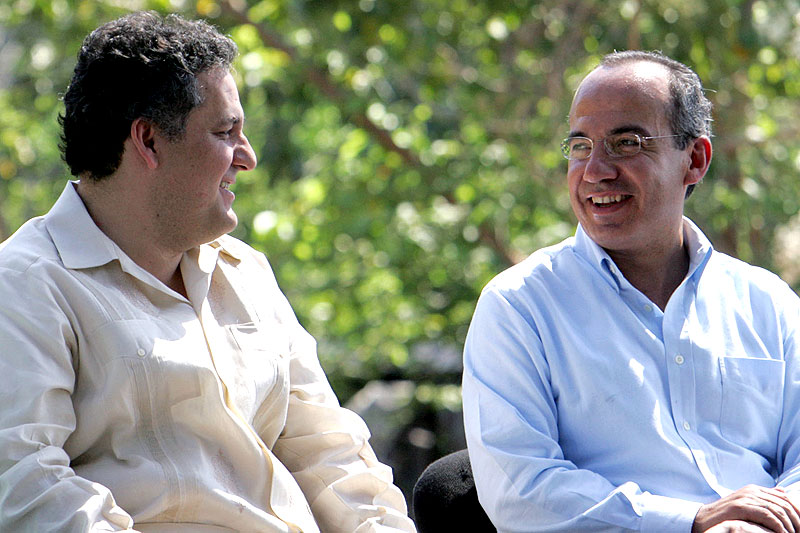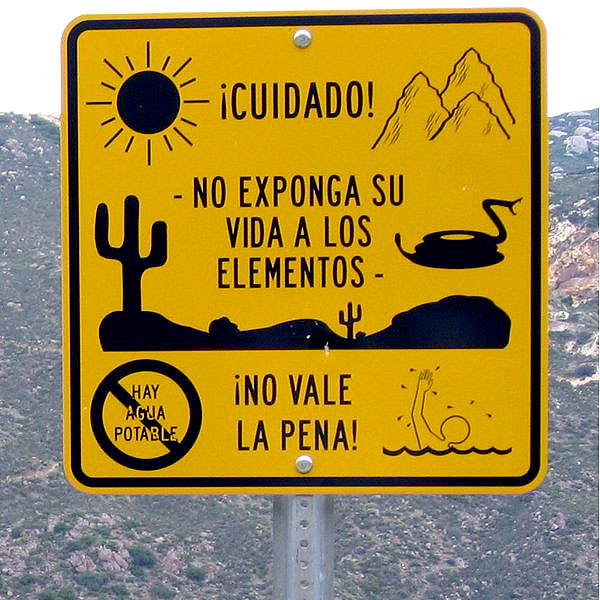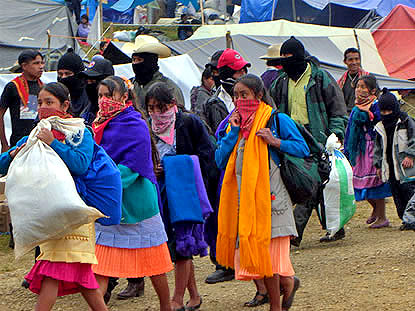
2006
02/01/2007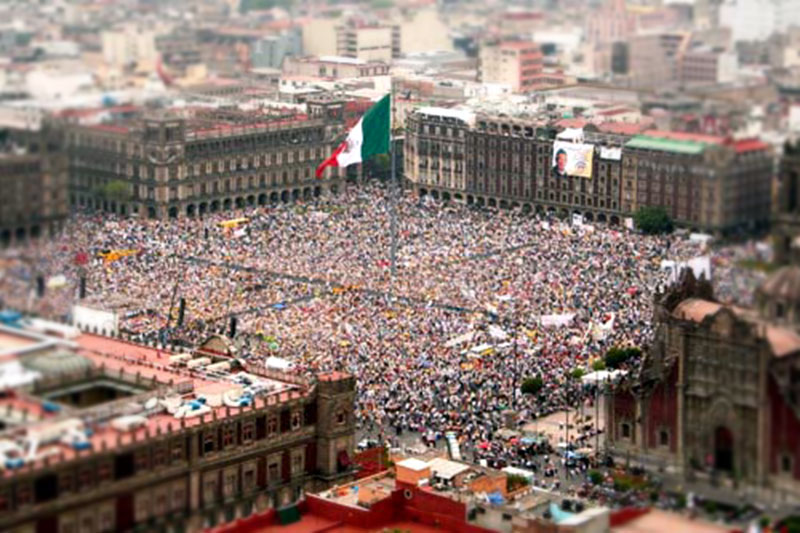
ANALYSIS: Mexico – A year after the 2006 elections
31/08/2007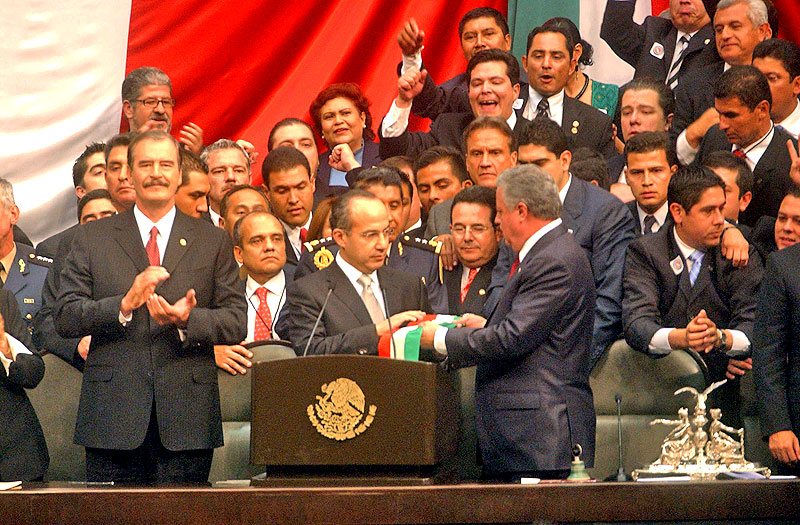 The first months of 2007 have coincided with the first months of Felipe Calderón as the president of the Republic and of Juan Sabines, as the governor of the state of Chiapas. On December 1st, Felipe Calderón was sworn in and confronted by a polarized Congress, violent struggles among the congressmen, and accompanied by a strong police-military operative. The first actions taken by his government allow us to anticipate what could be the main lines of his six year period of government regarding the most burning issues at the present time.
The first months of 2007 have coincided with the first months of Felipe Calderón as the president of the Republic and of Juan Sabines, as the governor of the state of Chiapas. On December 1st, Felipe Calderón was sworn in and confronted by a polarized Congress, violent struggles among the congressmen, and accompanied by a strong police-military operative. The first actions taken by his government allow us to anticipate what could be the main lines of his six year period of government regarding the most burning issues at the present time.
War against the drug traffic, in hands of the army
Regarding the struggle against crime (especially organized crime and drug trafficking), the Mexican government presented diverse initiatives, aimed at recovering the confidence in the security forces and at achieving a greater coordination between the diverse public entities involved in those tasks. Among other measures, 10,000 members of the army will be integrated into the Federal Preventive Police (PFP). On the other hand, military operations of great magnitude are being carried out against organized crime. Criticisms have not been absent regarding their real effectiveness beyond their impact on the mass media and on the possibility that it may only be a pretext to militarize the country. Moreover the multiple appearances of Calderon in military acts (even wearing the military uniform) have been questioned as an excessive rapprochement to the armed forces. During those acts he committed himself to increase the wages for the troops.
On January 19, several leaders of drug trafficking who had pending legal processes in Mexico were extradited to the United States. This decision was justified as necessary by Calderon by taking into consideration the vulnerability of the Mexican judges, who are often threatened and even murdered. The criticisms have been centered on the unconstitutional character of this measure (since the extradited ones were not provided with the due guarantees) and on the fact that it reflects the extreme weakness of the Mexican institutions. The violence associated with drug trafficking was one of the most urgent problems in the country. During the government of Vicente Fox (2000-2006) it produced an average of 1,500 annual murders(1).
Economic Policies
The opposition and diverse social movements speculate on the possible privatization of the public companies of the energy sector (Mexican Oils -PEMEX- and the Federal Commission of Electricity – CFE-), a possibility that has been denied by Calderón. It is necessary to remember that the benefits derived from the oil in Mexico represent 33 % of the national budget.
As for the policies against poverty, a line of continuity is foreseen although the new government has recognized errors during the government of Fox. One of the innovations will be that the welfare program “Opportunities,” emblematic of the last government, will be tied to productive projects and will promote microcompanies. The World Bank pointed out in its last report that 19 % of Mexicans are in a situation of extreme poverty, while a number of NGOs and social movements denounced that the expenses on social issues have diminished visibly in the new federal budget. The prices of diverse basic products have increased and, in January, a spectacular increase in the price of the Tortilla happened. The kilo of this basic food for Mexican families increased from about 6 Mexican pesos to 10 Mexican pesos, when the minimal daily salary is of approximately 50 Mexican pesos. Experts at UNAM (National Autonomous University of Mexico) warned that this increase affects especially the poorest families (19 million persons), whose income does not reach even 50 Mexican pesos daily and whose food is limited almost exclusively to this product.(2).
Human rights
In relation to human rights violations, which were especially serious in 2006 during the police operatives against the social mobilizations in Oaxaca and Atenco, diverse NGOs have expressed their fear that the new President may implement a politics of “iron hand”. Various worrisome signs exist: such as the detention of the leaders of APPO (Popular Assembly of the Peoples of Oaxaca) a few days after Calderón took office, Ramírez’s election as Secretary of the Interior (he has been accused by human rights organisms of being directly responsible for cases of torture and illegal detentions in the police repression against demonstrators during the summit of heads of state in Guadalajara in 2004, when he was governor of Jalisco); as well as the initiative of legal reforms so that detentions, housebreaking, telephone interventions without judicial authorization may be carried out. In the words of Calderon, “sometimes, to turn to the judicial authority makes the investigation more difficult”.
Other declarations of Calderon himself can be interpreted as being contradictive. On the one hand, he affirms: ” I do not believe in the iron hand, which has a connotation of not recognizing human rights,” and, on another, “we are determined not to tolerate challenges to the State authority.” At the end of January, Amnesty International denounced that Calderon “has not made public how he is going to fulfill his international commitments regarding human rights.” According to Amnesty, “the new government lacks a vision of human rights protection and does not tackle the structural shortcomings of the justice administration and of the public security”.
On March 8th, on International Women’s Day, the representative of the United Nations in Mexico published some concerning numbers of violence against women: at present, one woman of five suffers from violence from her partner and three out of five have suffered it at some time in their life(3). The same day, Amnesty International made public a report in which it states that in Mexico a very concerning degree of sexual violence exists from agents of the State who abuse women sexually (especially indigenous women) within a framework of total impunity(4).
Migration is another of the most urgent issues in Mexico, from a double perspective. On the one hand, the absence of economic alternatives is forcing an increasing number of persons to leave the country in search of employment. On the other hand, Mexico receives thousands of migrants from Central America that are on their way towards the United States. Although the Catholic Church and numerous NGOs demand the protection of these persons, who are in a situation of great vulnerability, there are signs that the persecution of undocumented persons may get worse (See Focus of this report).
On March 6, the Senate of the Republic approved by unanimity the decriminalization of the crimes of defamation, calumny and slander, which, according to diverse mass media, constitutes an indisputable advance for freedom of speech. Nevertheless, in Chiapas, the so-called Law “Mordaza” (gag law) remains in force (since 2004).It penalizes the crimes of defamation and calumny with the highest punishment of jail time in the whole of Latin America and is considered to be a serious attack to the freedom of press(5). Sabines, the new governor of Chiapas, committed himself to reform it during his campaign.
The opposition continues its path
Andrés Manuel López Obrador (AMLO) was named “legitimate president” by the National Democratic Convention, before hundreds of thousands of persons gathered for this purpose in the center of Mexico City on November 20 ratifying in this way its denial to recognize the government of Calderon. In February, AMLO declared himself “recovered” from the “blow” that supposed the assumed fraud. At present, he is making a tour to visit each one of the Mexican counties, focusing his speech on opposition to the privatization of the energy sector (especially of PEMEX), something he says he will prevent at all costs. He is already considering the next presidential elections in 2012: “It is very important to defend the patrimony of the country, because when this government finishes, we are going to receive a nation in disaster and it will be very difficult to move it forward.”
The Other Campaign, the initiative promoted by the EZLN to construct a new left wing movement (in the margin of the traditional political parties) with organizations of the whole country, concluded its trip of almost a year of duration on November 30, after having gone through the 32 federative entities of the Republic. On the other hand, the Encounter between the Zapatistas and the Peoples of the World was celebrated in Oventik, county of San Andrés Larrainzar (see the article in this Report).
The conflict in Oaxaca continues
The clashes between the popular movement and the security forces increased again on November 25, when agents of the PFP confronted members of APPO who were marching towards the historical center of Oaxaca City. This action resulted in more than 140 injured, 140 arrested and numerous cars and buildings set on fire. Various of the imprisoned persons were moved to penitentiary centers of Nayarit, which are located more than a thousand kilometers from the city of Oaxaca.
On December 4, only three days after President Felipe Calderón was sworn in, Flavio Sosa and three other leaders of the APPO were detained in the Federal District (where they were negotiating the renewal of the dialogue with the new government) for the crimes of sedition, attacks to the general routes of communication and incitement to violence. They were taken to a jail of maximum security in the state of Mexico, by request of the governor of Oaxaca, Ulises Ruiz, who considered the leaders of the movement “highly dangerous delinquents.”
On December 16, the PFP withdrew from the historical center of the Oaxaca City and on the following day 43 of the imprisoned persons in Nayarit were freed. In the following weeks, the APPO focused its mobilizations on demanding the liberation of the prisoners, with several sit-ins in front of the prisons, one of which was broken up violently.
On December 18, the Human Rights National Commission (public autonomous organism) published a document on the facts of violence in Oaxaca noting the following results since its beginning: 349 arrested persons, 370 injured persons and 20 deceased. In January, the Civil International Commission of Observation of the Human rights (CCIODH) presented its report(6), in which it stated the existence of a governmental strategy to terrify the population as a means to prevent the consolidation of the popular mobilization. This strategy, which they denounced left serious consequences between inhabitants of Oaxaca and included serious violations of human rights, one of them being 20 extrajudicial executions. The Human Rights director for the Secretary of the Interior denied the credibility of this report and of the CCIODH itself (“It does not have the respectability of other organizations, like Amnesty International“). Later these declarations were softened, and the Secretary expressed his willingness to analyze the report and to dialogue with the CCIODH.
In January, the dialogue between APPO and the federal government was suspended, leaving a negotiated exit to the conflict under great uncertainty. Various federal congressmen of the PRD (Party of the Democratic Revolution) committed themselves to denounce the governor of Oaxaca, Ulises Ruiz before the International Criminal Court for crimes against humanity committed in the last months.
Sabines, new governor of Chiapas
In December Juan Sabines took possession of his position as the new governor of Chiapas representing the Coalition for the Good of All (which includes the left wing parties PRD, Labor Party-PT – and Convergence), although he is ex-mayor of Tuxtla Gutiérrez for the Revolutionary Institutional Party (PRI). One of the first measures he took was the installation of a Special Commission “to attend to the requests from the diverse civil and rural groups that had been abandoned for years. Its purpose is to review the legal situation in which many persons have been deprived of their freedom in completing a penal judgment.” The main objective was to favor reconciliation, all of this, “without questioning the reasons and circumstances in which the justice of Chiapas pronounced its sentence”. The ambiguity in the writing of the communiqué caused doubts and preoccupation to many parts of the civil and social organizations in Chiapas, especially around two points: first, the possibility that it may be a strategy of political propaganda without a revision of the justice and penal system in the state; and, second, the fear that the imprisoned leaders of Peace and Justice (group accused of being paramilitary, especially active between 1995 and 2000) may be liberated.In deed, on February 15, the leaders of Peace and Justice imprisoned in the jail of El Amate, in Chiapas, asked in a public letter to be included in the amnesty, stating their “approval towards the good will (of the state government), for promoting a law of amnesty, which can benefit persons who belong to different social organizations and who are imprisoned “.
The conflicts continue
The most violent conflict in the last few months occurred in the county of Ocosingo, when hundreds of persons (including peasants of the Lacandona Community and uniformed persons) attacked 17 families installed in the village Viejo Velasco Suárez, in the Lacandona Jungle.This aggression, in the middle of a huge confusion on the number of victims and on their possible belonging to the EZLN, had a result of 4 persons dead, among them a pregnant woman, and 4 missing persons, presumably executed. Amnesty International has criticized seriously the governmental response to this situation(7). The Human Rights Center Fray Bartolomé de Las Casas emphasized that these weren’t “fights among men belonging to that same village” but acts made with “premeditation and with the complicity of the government authorities by action or omission with groups of interests in the region,” that have a “counter insurgency logic.”
Another of the relevant issues in Chiapas is the expansion of the Organization for the Defense of the Indigenous and ‘Campesino‘ Rights (OPDDIC). With a social base that is growing rapidly, it is an organization close to the PRI party that negotiates productive governmental projects and the land property titles for their members. Diverse NGOs, mass media and the EZLN denounce its supposedly paramilitary character and its clandestine armed activities. The OPDDIC has published various communiqués, declaring itself in favor of the governments of Juan Sabines and Felipe Calderón, and proving to be especially belligerent and threatening against the EZLN, in what seems to constitute a struggle for the land and the territory. On the one hand, they demand from the state and federal governments to act immediately against the communities of the EZLN, whom they consider to be “invading” the lands that the Zapatistas occupied after the uprising of 1994. On the other hand, they threaten the same communities of the EZLN with forced expulsions. Moreover they have threatened with death various organizations and civil activists: among them, the Human Rights Fray Bartolomé de las Casas (Frayba) and Miguel Ángel García Aguirre (of the organization Wood of the People of the Southeast).
This has not been the only new case of harassment against civil organizations in Chiapas. The Center of Economic and Political Investigations for Community Action (CIEPAC) of San Cristobal de Las Casas has also been an object of harassment and threats of death (See SIPAZ Website ) that needs to be added to the long list of actions against organizations of human rights and others that work in favor of peace in Chiapas in the last months.
- Article of La Jornada 10/1/2007 (Return…)
- Article of La Jornada 10/1/2007 (Return…)
- Article of La Jornada 8/3/2007 (Return…)
- Amnesty Internacional Website (Return…)
- Press communiqué CMI Chiapas (Return…)
- CCIODH Website (Return…)
- See Amnesty Internacional (Return…)

